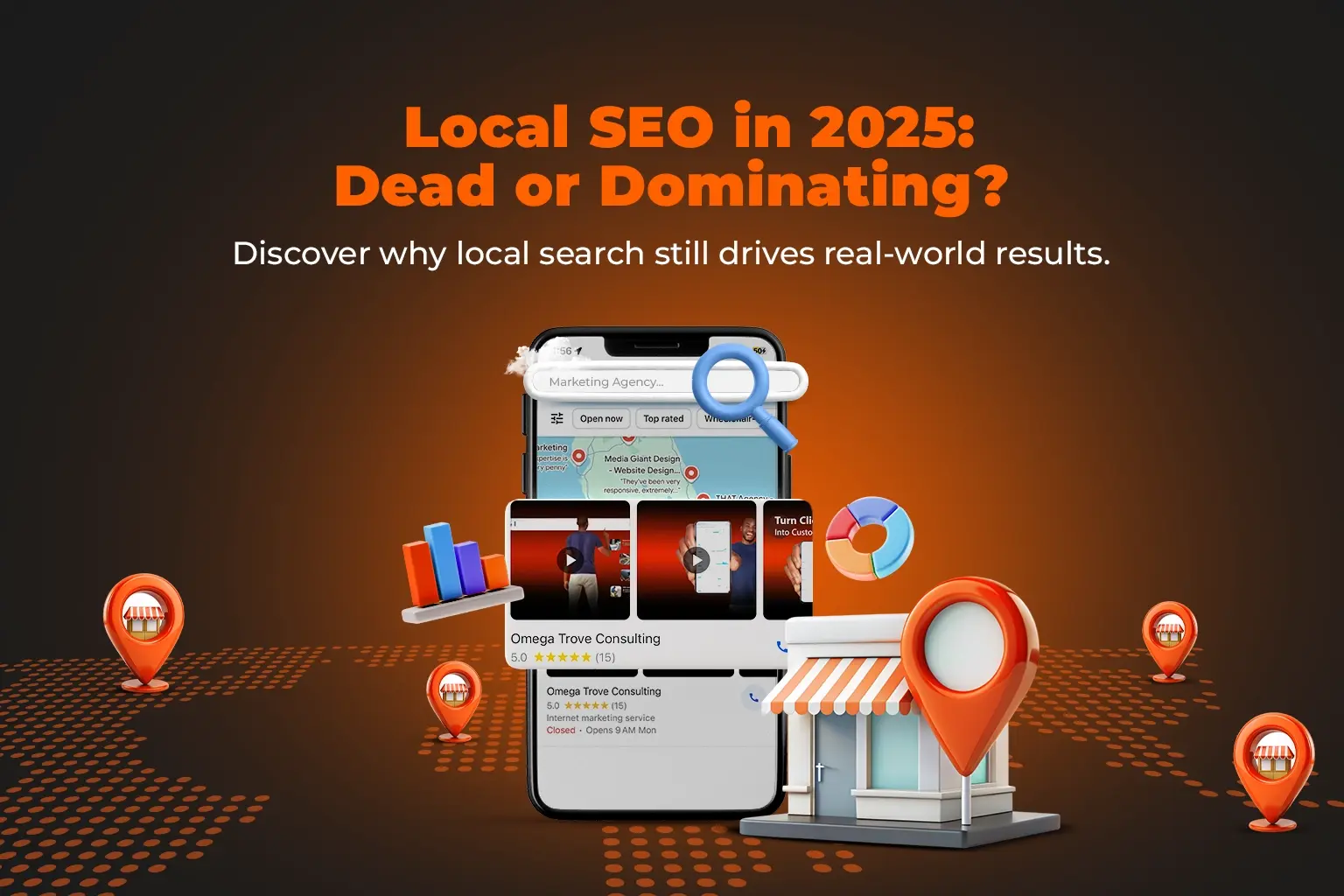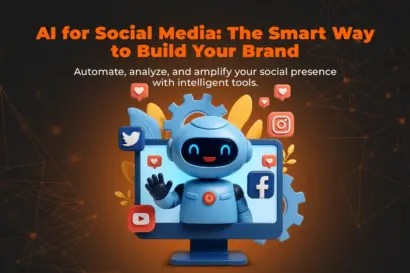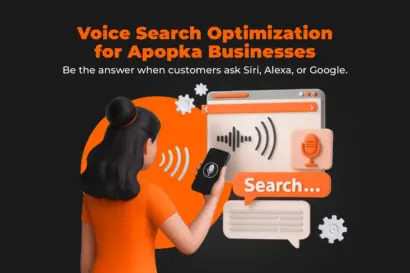Key Questions This Blog Will Answer
- Why the myth “local SEO is dead” persists
- Key data and ROI metrics proving its ongoing value
- How AI, voice search and generative engines are reshaping local optimization
- Actionable strategy to future-proof your local SEO
- 10 snippet-optimized FAQs for quick answers
Why Local Search Still Drives Real-World Revenue
With the rise of AI-powered search, generative engines like Google SGE, and the dominance of zero-click SERPs, it’s understandable that many marketers and business owners are questioning the future of local SEO. Is it still worth the investment? Or has traditional local optimization been rendered obsolete by new search behaviors?
Let’s set the record straight: Local SEO is far from dead. It’s simply evolving.
According to the latest digital behavior statistics, over 80% of U.S. consumers search online for local businesses on a weekly basis, and 32% perform these searches daily. That means nearly one-third of the population is actively looking for local services or businesses every single day. These aren’t passive browsers—they’re high-intent users often ready to call, visit, or book within minutes or hours of their search.
For service-based businesses, retailers, and location-specific professionals, ignoring local SEO in 2025 is like leaving money on the table. Even as AI-generated summaries and instant results change the search experience, local search remains one of the most powerful channels for connecting with ready-to-convert customers.
Source:
1. The Myth — Why People Think Local SEO Is Dead
Several industry voices claim that local SEO is shrinking because of:
- The rise of AI-driven responses (e.g., Google SGE/AI Overviews)
- “Zero-click” SERP features where users don’t leave search results
- Mobile apps & marketplaces drawing users away from traditional search
But here’s the reality check: A recent study found that 46% of Google searches have local intent.
Another source shows that approximately 28% of local searches result in a purchase, and 76% of “near me” searchers visit a business within a day.
Thus, the narrative that local SEO is dead is more fear than fact. The shift is not away from local search — it’s toward smarter, faster, mobile-centric and AI-driven local search.
Source:
2. The Evolution — How Local Search & Google Algorithms Have Changed
2.1 The 3 Core P’s: Relevance, Proximity, Prominence
According to experts, local ranking factors in 2025 cluster around:
- Relevance: How well a business matches the search intent.
- Proximity: The user’s location relative to the business.
- Prominence: Signals like reviews, citations, links, and brand authority.
2.2 Changing Signals, Changing Focus
In earlier years, you might have focused heavily on basic directory listings and keywords. In 2025:
- Having a complete and optimized Google Business Profile is non-negotiable. A full profile can receive 7x more clicks than incomplete ones.
- Service businesses often benefit from a dedicated page for each service type, plus strong internal linking.
- Mobile and voice search behaviours continue to evolve: For example, one source shows that 57% of all local searches in the U.S. come from mobile devices.
Source:
2.3 The Impact of Algorithm Shifts
As search engines incorporate more AI and judge quality based on user experience, local SEO must respond accordingly. Schema markup, entity-based content, structured data — these are no longer optional; they’re essential components.
3. AI, Voice & Generative Search — The Future of Local Visibility
3.1 Generative Search & Zero-Click Threats
With systems like Google SGE and other AI assistants, search is moving toward shorter answer-rich results, sometimes without any click. One study shows 58–60% of Google searches now end in zero-click results.
For local businesses, this means your content must serve both humans and the machine: answer searcher intent directly, use structured content, and format for snippet capture.
3.2 Voice & Conversational Queries
Voice search is booming. Over 1 billion voice searches occur each month, and ~20% of all mobile queries are voice-based.
Local SEO must now factor in conversational phrasing (“near me”, “open now”, “what’s the best … nearby”). This affects how you select keywords, structure FAQs, and build content.
3.3 AI + Local = Smart Optimization
Rather than view AI as a threat, treat it as an amplifier:
- Use FAQ content and schema to feed generative engines
- Leverage user-generated reviews and signals as trust anchors
- Monitor new SERP features (e.g., Maps, “Visit” buttons, answer cards) shifting local traffic
In short: local SEO isn’t dead — it’s simply entering a new phase.
4. Why Local SEO Still Works — Data & ROI That Matters
4.1 High-Intent Traffic
Some compelling data points:
- 80% of U.S. consumers search online for local businesses weekly.
- Of mobile local searches, 18% convert within 24 hours.
- In a dataset, local business profiles receive on average over 21,600 views per year.
4.2 Superior Conversion Rates
Unlike generic traffic, local searches often mean purchase intent:
- A benchmark shows ~28% of local searches result in a purchase.
- SEO campaigns can deliver ROI of 748% or more, according to aggregated ROI research.
4.3 Strategic Advantage for SMBs
For small or service-area businesses (SABs) the barrier to entry is lower than national brands:
- Tailoring content by location, optimizing GBP, collecting reviews — these are relatively inexpensive yet high impact.
- As one article points out, 58% of businesses still don’t optimize for local search, leaving opportunity on the table.
Source:
5. How to Future-Proof Your Local SEO Strategy in 2025 & Beyond
5.1 Optimize Your Google Business Profile & Citations
- Ensure your name, address, phone (NAP) are consistent across platforms. See What Is NAP Consistency?
- Complete every field in your GBP, include high-quality photos, update regularly.
- Use location-specific service descriptions and keywords.
5.2 Build Content With Entity & Intent Focus
- Target pages by service and location: “Emergency Plumbing Orlando Area”
- Leverage schema markup: services, reviews, local business type
Learn more:
5.3 Collect Reviews & Use Social Proof
- Review signals remain a top local ranking factor. Encourage timely responses, user-generated content.
- Have review-rich snippets on your site; embed or call out review ratings.
Learn more:
What Is a Review Signal in SEO?
5.4 Leverage Voice, Mobile & Generative Search
- Structure content in conversational Q&A format for voice queries
- Use FAQ schema with internal links
- Format for featured snippets and answer cards (“What is the best … near me?”)
5.5 Measure & Iterate
- Track local traffic, GBP clicks/calls, mobile conversion rate
- Monitor new SERP features and adjust (e.g., if map pack clicks drop, evaluate page load/mobile UX)
- Test content variation, service-page layouts, CTAs and review placements
Conclusion
To recap: Local SEO is not dead — it’s evolving. In 2025 and beyond, the landscape has shifted dramatically. We’re seeing greater importance placed on mobile access, voice‑search readiness, generative AI results, and hyper‑local relevance. But while the methods have changed, the core principles that drive local visibility—intent, trust, and proximity—remain as critical as ever
For local‑service businesses, that means one thing: you cannot afford to ignore local optimization. When you appear in credible local results—Google Business Profiles, map packs, voice search answers—you capture customers who are often ready to act within hours of their search. The cost of inaction is not just missed clicks, but missed walk‑ins, calls, and payments.
Frequently Asked Questions
1. Why is local SEO still relevant in 2025?
Local SEO remains one of the most effective strategies for capturing high-intent search traffic. With approximately 80% of consumers performing local searches weekly and 28% of those searches leading to a purchase, optimizing for local visibility is far from obsolete. Consumers increasingly rely on search engines to find nearby services, making local SEO a critical tool for businesses aiming to attract and convert local audiences.
2. What does “local intent” mean in search queries?
“Local intent” refers to searches that indicate a user is looking for results within a specific geographic area, whether explicitly mentioned (like a city or ZIP code) or implied through phrases such as “near me” or “open now.” Studies show that around 46% of all Google searches carry local intent, making it essential to tailor content and metadata to capture this type of traffic.
Learn more:
3. How does AI affect local SEO in 2025?
AI has introduced more personalized search results, including generative summaries, instant answers, and voice search responses. While this reduces some traditional web traffic, local SEO adapts by focusing on structured data, FAQ schema, Google Business Profile optimization, and entity recognition. Businesses that feed clean, localized data into these AI systems remain visible and competitive in search results.
4. Is mobile optimization still necessary for local SEO?
Yes—mobile usage continues to dominate local search behavior. Over 57% of local searches are initiated on smartphones, and mobile-first indexing by Google means the mobile version of your site is what search engines prioritize. A fast, responsive, and user-friendly mobile experience is essential for capturing leads from on-the-go users.
5. How important are online reviews for local SEO rankings?
Reviews are among the most influential local SEO signals. A strong volume of positive, recent reviews—especially with keyword-rich content and business responses—can significantly improve visibility in the local pack. Search engines treat reviews as a form of social proof, helping build both credibility and ranking authority.
6. Do businesses need separate location pages for SEO?
Yes. If a business serves multiple areas or has several branches, dedicated location pages improve keyword relevance, internal linking structure, and on-page optimization. Each page should feature unique content, service-specific keywords, and localized schema to help search engines clearly understand your service footprint.
7. Can small service-based businesses still compete with large brands through local SEO?
Absolutely. Local SEO levels the playing field by prioritizing proximity, relevance, and prominence—not budget. Smaller businesses can outperform larger competitors through optimized listings, consistent NAP citations, locally-focused content, and active review strategies. Many larger brands still overlook hyper-local optimization, creating space for smaller players to thrive.
8. What kind of ROI can local SEO provide?
Local SEO continues to offer one of the highest returns in digital marketing. Campaigns that focus on proper on-page SEO, citations, and GBP optimization can deliver returns upwards of 700%, depending on industry and competition. Because searchers with local intent are often closer to a purchasing decision, the conversion potential is significantly higher.
9. Will AI and answer engines eliminate the need for traditional local SEO?
No. While AI changes how users interact with search engines, local SEO remains foundational. Optimizing for generative AI requires clear, concise, structured data—precisely the focus of modern SEO. Tools like voice search, Google’s AI Overviews, and map results still rely on verified business data and user signals.
10. What are the best steps to future-proof a local SEO strategy?
Start with a fully optimized Google Business Profile. Follow with a mobile-first website, localized service pages, structured data (schema markup), and a review management process. Use tools like Google Search Console, GA4, and BrightLocal to track performance and continuously adapt to algorithm updates. Staying consistent and responsive is the key to maintaining long-term success in local search.





